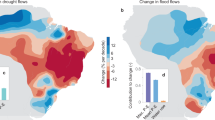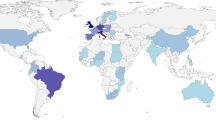Abstract
Encouraging adaptation is an essential aspect of the policy response to climate change1. Adaptation seeks to reduce the harmful consequences and harness any beneficial opportunities arising from the changing climate. However, given that human activities are the main cause of environmental transformations worldwide2, it follows that adaptation itself also has the potential to generate further pressures, creating new threats for both local and global ecosystems. From this perspective, policies designed to encourage adaptation may conflict with regulation aimed at preserving or enhancing environmental quality. This aspect of adaptation has received relatively little consideration in either policy design or academic debate. To highlight this issue, we analyse the trade-offs between two fundamental ecosystem services that will be impacted by climate change: provisioning services derived from agriculture and regulating services in the form of freshwater quality. Results indicate that climate adaptation in the farming sector will generate fundamental changes in river water quality. In some areas, policies that encourage adaptation are expected to be in conflict with existing regulations aimed at improving freshwater ecosystems. These findings illustrate the importance of anticipating the wider impacts of human adaptation to climate change when designing environmental policies.
This is a preview of subscription content, access via your institution
Access options
Subscribe to this journal
Receive 12 print issues and online access
$209.00 per year
only $17.42 per issue
Buy this article
- Purchase on Springer Link
- Instant access to full article PDF
Prices may be subject to local taxes which are calculated during checkout



Similar content being viewed by others
Change history
24 February 2015
In the version of this Letter originally published the title was incorrect. This error has been corrected in the online versions.
References
Pielke, R., Prins, G. P., Rayner, S. & Sarewitz, D. Lifting the taboo on adaptation. Nature 445, 597–598 (2007).
Vitousek, P. M., Mooney, H. A., Lubchenco, J. & Melillo, J. M. Human domination of Earth’s ecosystems. Science 277, 494–499 (1997).
Lobell, D. B., Schlenker, W. & Costa-Roberts, J. Climate trends and global crop production since 1980. Science 333, 616–620 (2011).
Sterling, S. M., Ducharne, A. & Polcher, J. The impact of global land-cover change on the terrestrial water cycle. Nature Clim. Change 3, 385–390 (2013).
McIsaac, G. F., David, M. B., Gertner, G. Z. & Goolsby, D. A. Eutrophication: Nitrate flux in the Mississippi River. Nature 414, 166–167 (2001).
Conley, D. J. Ecology: Save the Baltic Sea. Nature 486, 463–464 (2012).
Water Quality Standards Handbook 2nd edn, EPA-823-B-12-002 (Environmental Protection Agency, 2012)
European Commission, Water Framework Directive. J. Eur. Comm. 43(L327), 1–72 (2000).
Willis, K. J. & Bhagwat, S. A. Biodiversity and climate change. Science 326, 806–807 (2009).
Goldstein, J. H. et al. Integrating ecosystem-service tradeoffs into land-use decisions. Proc. Natl Acad. Sci. USA 109, 7565–7570 (2012).
European Commission, Nitrates Directive. J. Eur. Comm. 34(L375), 1–8 (1991).
Bateman, I. J. et al. Bringing ecosystem services into economic decision making: Land use in the UK. Science 314, 45–50 (2013).
Lawler, J. J. et al. Projected land-use impacts on ecosystem services in the United States. Proc. Natl Acad. Sci. USA 111, 7492–7497 (2014).
Johnson, J. A., Runge, C. F., Senauer, B., Foley, J. & Polasky, S. Global agriculture and carbon trade-offs. Proc. Natl Acad. Sci. USA 111, 12342–12347 (2014).
Polasky, S., Lewis, D., Plantinga, A. & Nelson, E. Implementing the optimal provision of ecosystem services. Proc. Natl Acad. Sci. USA 111, 6248–6253 (2014).
Fezzi, C. & Bateman, I. J. Structural agricultural land use modeling for spatial agro-environmental policy analysis. Am. J. Agric. Econ. 93, 1168–1188 (2011).
Kling, C. Economic incentives to improve water quality in agricultural landscapes: Some new variations on old ideas. Am. J. Agric. Econ. 93, 297–309 (2011).
Jarvie, H. P., Neal, C. & Withers, P. J. A. Sewage-effluent phosphorus: A greater risk to river eutrophication than agricultural phosphorus? Sci. Total Environ. 360, 246–253 (2006).
UK Climate Impacts Programme (UKCIP) UK Climate Projection: Briefing Report (Met Office Hadley Centre, 2011).
Government Forestry and Woodlands Policy Statements Incorporating the Government’s Response to the Independent Panel on Forestry’s Final Report (Department for Environmental, Food and Rural Affairs, 2013); https://www.gov.uk/government/publications/government-forestry-policy-statement
The State of Natural Capital: Restoring Our Natural Assets (Natural Capital Committee, 2014); http://www.defra.gov.uk/naturalcapitalcommittee
De Cian, E., Lanzi, E. & Roson, R. Seasonal temperature variations and energy demand: A panel cointegration analysis for climate change impact assessment. Climatic Change 116, 805–825 (2013).
Barange, M. et al. Impacts of climate change on marine ecosystem production in societies dependent on fisheries. Nature Clim. Change 4, 211–216 (2014).
Guo, C. & Costello, C. The value of adaptation: Climate change and timberland management. J. Environ. Econ. Manage. 65, 452–468 (2013).
Patz, J. A., Campbell-Lendrum, D., Holloway, T. & Foley, J. A. Impact of regional climate change on human health. Nature 438, 310–317 (2005).
Nisson, M. et al. Understanding policy coherence: Analytical framework and examples of sector–environment policy interactions in the EU. Environ. Policy Governance 22, 395–423 (2012).
Amemiya, T. Regression analysis when the dependent variable is truncated normal. Econometrica 41, 997–1016 (1973).
GQA Headline Indicators of Water Courses (Nutrients) (Environment Agency, 2012)
Kennedy, M. Introducing Geographic Information Systems with ArcGIS 433–443 (John Wiley, 2009).
Nakicenovic, N. & Swart, R. Special Report on Emissions Scenarios (IPCC, Cambridge Univ. Press, 2000).
Acknowledgements
This research was supported by the European Union Marie Curie International Outgoing Fellowship ‘Land Use Change, Environment and Society (LUCES)’ (Ref: FP7-PEOPLE-2011-IOF-302290), the SEER Project, funded by the ESRC (ref: RES-060-25-0063) and WEPGN, Brock University. We thank R. Carson, S. Ferrini and K. Schwabe for their helpful comments on a previous version of this paper, and A. De-Gol for his assistance with the UKCIP data.
Author information
Authors and Affiliations
Contributions
The analysis was designed by C.F. with contributions from I.J.B. and all the authors, A.R.H. and A.A.L. undertook the data collection and the Geographical Information System analysis, C.F. undertook the econometric analysis of the land-use and the water-quality models, C.F. and I.J.B. wrote the paper with contributions from all the authors.
Corresponding author
Ethics declarations
Competing interests
The authors declare no competing financial interests.
Supplementary information
Rights and permissions
About this article
Cite this article
Fezzi, C., Harwood, A., Lovett, A. et al. The environmental impact of climate change adaptation on land use and water quality. Nature Clim Change 5, 255–260 (2015). https://doi.org/10.1038/nclimate2525
Received:
Accepted:
Published:
Issue Date:
DOI: https://doi.org/10.1038/nclimate2525
This article is cited by
-
Maladaptation in an unequal world: an evolutionary model with heterogeneous agents
Annals of Operations Research (2024)
-
Perception of health risks in contexts of extreme climate change in semiarid Northeastern Brazil: an analysis of the role of socioeconomic variables
Journal of Ethnobiology and Ethnomedicine (2023)
-
The impact of climate change on crop mix shift in the Nordic region
Scientific Reports (2023)
-
The interactions among landscape pattern, climate change, and ecosystem services: progress and prospects
Regional Environmental Change (2023)
-
Does risk preference influence farm level adaptation strategies? – Survey evidence from Denmark
Mitigation and Adaptation Strategies for Global Change (2023)



